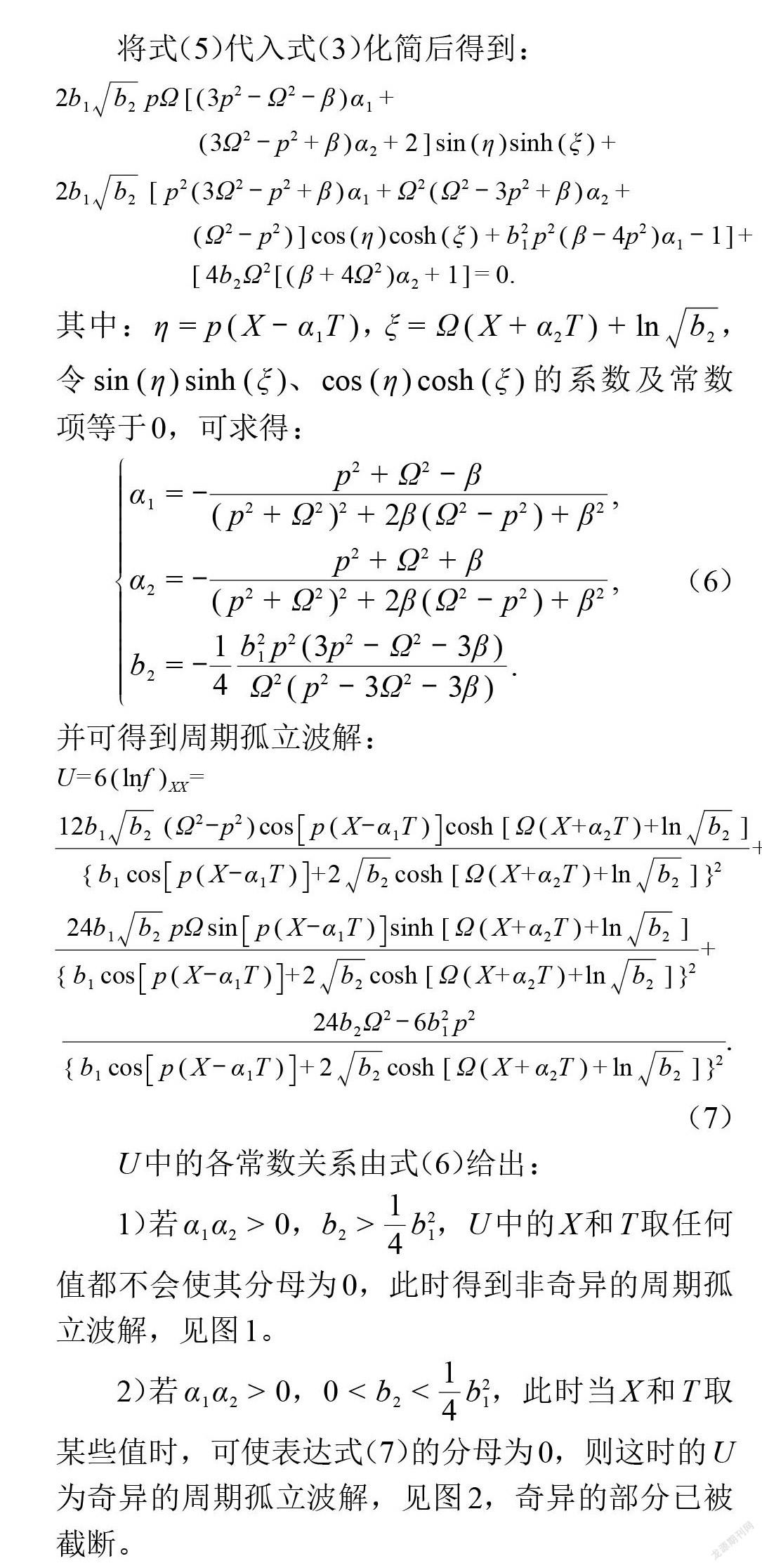广义Vakhnenko方程新的周期孤立波解
2022-07-08杨川李栋龙周虹
杨川 李栋龙 周虹





摘 要:应用Hirota方法及扩展的同宿测试法对广义的Vakhnenko方程进行研究,获得了该方程周期孤立波解。
关键词:Hirota方法;扩展的同宿测试法;广义Vakhnenko方程;周期孤立波解
中图分类号:O175.2 DOI:10.16375/j.cnki.cn45-1395/t.2022.03.018
0 引言
随着当代数学和物理学的发展,非线性科学日显重要,其中非线性偏微分方程是非线性科学的重要内容之一,故寻找非线性偏微分方程的精确解是数学家和物理学家的重要研究课题。至今,人们创造并发展了很多求非线性方程精确解的方法,如逆散射法[1]、Bäcklund变换法[2]、齐次平衡法[3]、双曲函数展开法[4]、扩展的双曲函数展开法[5]、Jacobi椭圆函数展开法[6]和Hirota变换法[7]等。近年来,许多学者致力于Hirota变换法的各种推广和应用[8-11],使得Hirota变换法有了进一步的发展和拓展。这些求解非线性方程精确解的方法有力地推动了非线性科学的发展。
Vakhnenko方程(Vakhnenko equation,VE)是研究某种处于松弛介质中的高频波的数学模型[12],公式如式(1)所示:
[∂∂xAu+u=0 ]. (1)
其中:[A=∂∂t+u∂∂x] ,[u]表示无维压力变量,[x]和[t]分别表示空间和时间变量。对于边界条件,即当[|x|→∞]时,[u→0],具有多回形孤子解[13]。
广义的Vakhnenko方程(generalised Vakhnenko equation,GVE)[14],即:
[∂∂x(A2u+qu2+βu)+qAu=0] . (2)
其中:[β]、[q]是任意的非零常數,其具有回形孤子解、驼峰型和尖型孤子解。Vakhnenko等[15]用Bäcklund转换法和逆散射法对方程在[q=1]时进行了求解,分别得到了方程具有一个无限序列守恒定律的结论和N-孤子解。El-Nahhas[16]用同伦分析法对Vakhnenko方程求解并得到了单回形孤子解。Hirota等[17]用因变量转换法(dependent variables transition,DVT)求出多孤子解。Li[18]通过研究描述电磁物理学中高频波(high frequency wave,HFW)传播的Vakhnenko方程来描述一种新型的呼吸器。通过在Hirota双线性法中将双线性函数扩展为混合指数函数和三角余弦函数,构建了一个解析多值函数解,这是一个经过验证的环状扭结呼吸器。Abdou等[19]基于三波法得到Vakhnenko方程单一的周期孤立波解。Li等[20]基于扩展的同宿测试法获得Vakhnenko方程的N-loop解。本文主要应用Hirota方法及扩展的同宿测试法在文献[14]基础上对广义的Vakhnenko方程(GVE) 求解其周期孤立波解并对解进行讨论。
1 精确解及解的分析
式(2)([q=1])对应的双线性形式[14]为:
[(βDXDT+D3XDT+D2X)f⋅f=0]. (3)
其中:X、T分别表示空间和时间变量。
Hirota双线性算子定义为:
[DmxDkt(a⋅b)=(∂∂x-∂∂x)m(∂∂t-]
[∂∂t)ka(x, t)b(x, t)|x=x, t=t] . (4)
为了获得新周期孤立波解,作如下假设:
假设1
[f=e-Ω(X+α2T)+b1cosp(X-α1T)+b2eΩ(X+α2T)].(5)
其中:[αj、bj、p、Ω(j=1, 2)]是实数。
将式(5)代入式(3)化简后得到:
[2b1b2pΩ[(3p2-Ω2-β)α1+ (3Ω2-p2+β)α2+2]sin(η)sinh(ξ)+2b1b2[p2(3Ω2-p2+β)α1+Ω2(Ω2-3p2+β)α2+ (Ω2-p2)]cos(η)cosh(ξ)+b21p2(β-4p2)α1-1]+ [4b2Ω2[(β+4Ω2)α2+1]=0.]
其中:[η=p(X-α1T)], [ξ=Ω(X+α2T)+lnb2],令[sin(η)sinh(ξ)]、[cos(η)cosh(ξ)]的系数及常数项等于0,可求得:
[α1=-p2+Ω2-β(p2+Ω2)2+2β(Ω2-p2)+β2, α2=-p2+Ω2+β(p2+Ω2)2+2β(Ω2-p2)+β2,b2=-14b21p2(3p2-Ω2-3β)Ω2(p2-3Ω2-3β).] (6)
并可得到周期孤立波解:
[U=6(lnf)XX=12b1b2(Ω2-p2)cosp(X-α1T)cosh[Ω(X+α2T)+lnb2]{b1cosp(X-α1T)+2b2cosh[Ω(X+α2T)+lnb2]}2+24b1b2pΩsinp(X-α1T)sinh[Ω(X+α2T)+lnb2]{b1cosp(X-α1T)+2b2cosh[Ω(X+α2T)+lnb2]}2+][24b2Ω2-6b21p2{b1cosp(X-α1T)+2b2cosh[Ω(X+α2T)+lnb2]}2].(7)
[U]中的各常数关系由式(6)给出:
1)若[α1α2>0],[b2>14b21],[U]中的[X]和[T]取任何值都不会使其分母为0,此时得到非奇异的周期孤立波解,见图1。
2)若[α1α2>0],[0<b2<14b21],此时当[X]和[T]取某些值时,可使表达式(7)的分母为0,则这时的[U]为奇異的周期孤立波解,见图2,奇异的部分已被截断。
假设2
[f=e-Ω(X+α2T)+b1sinp(X-α1T)+b2eΩ(X+α2T)] . (8)
将式(8)代入式(3)化简后得到:
[2b1b2pΩ[(3p2-Ω2-β)α1+(3Ω2-p2+β)α2+2]cos(η)sinh(ξ)+2b1b2[p2(3Ω2-p2+β)α1+Ω2(Ω2-3p2+β)α2+(Ω-p2)]sin(η)cosh(ξ)+b21p2[(β-4p2)α1-1]+4b2Ω2[(β+4Ω2)α2+1]=0.]
其中:[η=p(X-α1T)],[ξ=Ω(X+α2T)][+lnb2],令[cos(η)sinh(ξ)]、[sin(η)cosh(ξ)]的系数及常数项等于0,得到的系数关系同假设1的式(6),此时可得到周期孤立波解为:
[U=12b1b2(Ω2-p2)sinp(X-α1T)cosh[Ω(X+α2T)+lnb2]{b1sinp(X-α1T)+2b2cosh[Ω(X+α2T)+lnb2]}2+ 24b1b2pΩcosp(X-α1T)sinh[Ω(X+α2T)+lnb2]{b1sinp(X-α1T)+2b2cosh[Ω(X+α2T)+lnb2]}2+][ 24b2Ω2-6b21p2{b1sinp(X-α1T)+2b2cosh[Ω(X+α2T)+lnb2]}2] . (9)
[U]中的各常数关系由式(6)决定:
1)若[α1α2>0,],[b2>14b21],得到非奇异的周期孤立波解,见图1。
2)若[α1α2>0],[0<b2<14b21],此时当[X]和[T]取某些值时,使表达式(9)的分母为0,则这个时候的[U]为奇异的周期孤立波解,见图2,奇异的部分已被截断。
假设3
[f=b1cosp(X-α1T)+b2eΩ(X+α2T)-e-Ω(X+α2T)]. (10)
将式(10)代入式(3)得到的系数关系同式(6),此时的周期孤立波解为:
[U=12b1b2(Ω2-p2)cosp(X-α1T)sinh[Ω(X+α2T)+lnb2]{b1cosp(X-α1T)+2b2sinh[Ω(X+α2T)+lnb2]}2+ 24b1b2pΩsinp(X-α1T)cosh[Ω(X+α2T)+lnb2]{b1cosp(X-α1T)+2b2sinh[Ω(X+α2T)+lnb2]}2-][ 24b2Ω2+6b21p2{b1cosp(X-α1T)+2b2sinh[Ω(X+α2T)+lnb2]}2.](11)
这完全是一个奇异的周期孤立波解,见图3和图4。
假设4
[f=b1sinp(X-α1T)+b2eΩ(X+α2T)-e-Ω(X+α2T)]. (12)
将式(11)代入式(3)运算化简得到的系数关系同式(6),此时的周期孤立波解为:
[U= 12b1b2(Ω2-p2)sin[p(X-α1T)]sinh[Ω(X+α2T)+lnb2]{b1sin[p(X-α1T)]+2b2sinh[Ω(X+α2T)+lnb2]}2 - 24b1b2pΩcos[p(X-α1T)]cosh[Ω(X+α2T)+lnb2]{b1sin[p(X-α1T)]+2b2sinh[Ω(X+α2T)+lnb2]}2-][ 24b2Ω2+6b21p2{b1sin[p(X-α1T)]+2b2sinh[Ω(X+α2T)+lnb2]}2 .](13)
这也完全是一个奇异的周期孤立波解,见图3和图4。
2 结论
本文主要应用Hirota方法及扩展的同宿测试法获得了广义的Vakhnenko方程的周期孤立波解。这些解是包含一个周期解和一个孤立波的双波,它反映了周期解和孤立波的弹性碰撞,这是一个有趣的物理现象,证明了广义的Vakhnenko方程解的复杂性以及各种动力学行为。
参考文献
[1] ABLOWITZ M J,SEGUR H. Solitons and inverse scattering transform[M]. Philadelphia:SIAM,1981.
[2] BÄCKLUND A V. Concerning surfaces with constant negative curvature[M]. Lancaster:New Era Printing,1905.
[3] WANG M L,ZHOU Y B,LI Z B. Application of a homogeneous balance method to exact solutions of nonlinear equations in mathematical physics[J]. Physics Letters A,1996,216(1-5):67-75.
[4] PARKES E J,DUFY B R. Travelling solitary wave solutions to a compound KdV-Burgers equation[J]. Physics Letters A,1997,229:217-220.
[5] FAN E G. Extend tanh-function method and its applications to nonlinear equations[J]. Physics Letters A,2000,277(4-5): 212-218.
[6] FU Z T,LIU S K,LIU S D,et al. New Jacobi elliptic functione expansion and new periodic solutions of nonlinear wave equations[J]. Physics Letters A,2001,290(1-2):72 -76.
[7] HIROTA R,GILSON C,NIMMO J,et al. The direct method in soliton theory[M]. Cambridge:Cambridge University Press,2004.
[8] DAI Z D,JIANG M R,DAI Q Y,et a1. Homoclinic bifurcation for the Boussinesq equation with even constraints[J]. Chinese Physics Letters,2012,23(5):1065-1067.
[9] DAI Z D,LIU Z J,LI D L. Exact periodic solitary-wave solutions for KdV equation[J]. Chinese Physics Letters,2008,25(5):1531-1533.
[10] DAI Z D,LIU J,ZENG X P,et al. Periodic kink-wave and kinky periodic-wave solutions for the Jimbo-Miwa equation[J]. Physics Letters A,2008,372(38):5984-5986.
[11] DAI Z D,LIN S Q,FU H M,et al. Exact three-wave solutions for the KP equation[J]. Applied Mathematics and Computation,2010,216(5):1599-1604.
[12] VAKHNENKO V O. High-frequency soliton-like waves in a relaxing medium[J]. Journal of Mathematical Physics,1999,40(4):2011-2020.
[13] WU Y Y,WANG C,LIAO S J. Solving the one-loop soliton solution of the Vakhnenko equation by means of the homotopy analysis method[J]. Chaos, Solitons and Fractals,2005,23(5):1733-1740.
[14] MORRISON A J,PARKES E J. The N-soliton solution of the modified generalised Vakhnenko equation (a new nonlinear evolution equation)[J]. Chaos, Solitons and Fractals,2003,16(1):13-26.
[15] VAKHNENKO V O,PARKES E J,MORRISON A J. A Bäcklund transformation and the inverse scattering transform method for the generalised Vakhnenko equation[J]. Chaos, Solitons and Fractals,2003,17(4):683-692.
[16] NAHHAS A E. Analytic approximations for the one-loop soliton solution of the Vakhnenko equation[J]. Chaos, Solitons and Fractals,2009,40(5):2257-2264.
[17] HIROTA R,SATSUMA J. N-soliton solutions of model equations for shallow water waves[J]. Journal of the Physical Society of Japan,1976,40(2):611-612.
[18] LI B Q. Loop-like kink breather and its transition phenomena for the Vakhnenko equation arising from high-frequency wave propagation in electromagnetic physics[J]. Applied Mathematics Letters,2021,112:106822.
[19] ABDOU M A,SOLIMAN A A,ELGARAYHI A. New periodic solitary wave solutions for an extended generalization of Vakhnenko equation[J]. Journal of the Association of Arab Universities for Basic and Applied Sciences,2015,18(C): 99-101.
[20] LI B Q,MA Y L,MO L P,et al. The N-loop soliton solutions for (2+1)- dimensional Vakhnenko equation[J].Computers and Mathematics with Applications,2017,74(3):504-512.
New periodic solitary wave solutions for generalized Vakhnenko
equation
YANG Chuan1, LI Donglong2, ZHOU Hong1
(1. School of Electronic Information Engineering, Liuzhou Vocational and Technical College, Liuzhou 545006, China; 2.College of Science, Guangxi University of Science and Technology, Liuzhou 545006, China)
Abstract: Periodic solitary wave solutions of the generalized Vakhnenko equation are obtained by Hirota method and the extended homoclinic test method.
Key words: Hirota method; extended homoclinic test method; generalized Vakhnenko equation; periodic solitary wave solution
(責任编辑:于艳霞)
